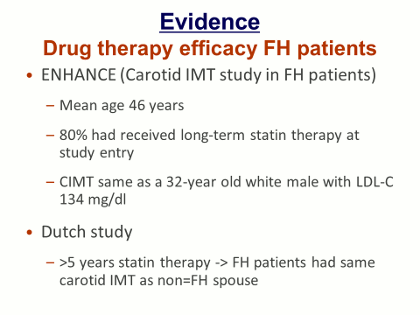Robinson - Figure 6 - Evidence (ENHANCE) Text
If we look at the primary characteristics of patients in the Ezetimibe and Simvastatin in Hypercholesterolemia Enhances Atherosclerosis Regression (ENHANCE) study[11] there is an important lesson for our understanding of FH patients, having nothing to do with the hypothesis that was tested in that trial or with the results. ENHANCE was an imaging study of the intimal medial thickness (IMT) of the carotid artery (carotid IMT, or cIMT) in patients treated with a statin or with a statin plus an intestinal cholesterol absorption inhibitor in widespread clinical use (ezetimibe). The design of the trial, the methodology, and the interpretation of the results are fairly well known and still the subject of ongoing discussion and debate. There are, however, a couple of interesting and important points from the trial that physicians should bear in mind when thinking about their FH patients.
- The patients enrolled in ENHANCE had a mean age of 46 and all had FH.
- At baseline, 80% of the patients had been on long-term statin therapy, and baseline imaging revealed a mean cIMT measurement that was equivalent to that of a 32-year-old white male with a serum LDL cholesterol level of 134 mg/dL.
References
[11]Kastelein JJP, Akdim F, Stroes ESG, et al. Simvastatin with or without Ezetimibe in Familial Hypercholesterolemia. N Engl J Med 2008; 358:1431-1443.
[12]Sivapalaratnam S, van Loendersloot LL, Hutten BA, et al. Long-term LDL-c lowering in heterozygous familial hypercholesterolemia normalizes carotid intima-media thickness. Atherosclerosis 2010;212:571-574.
